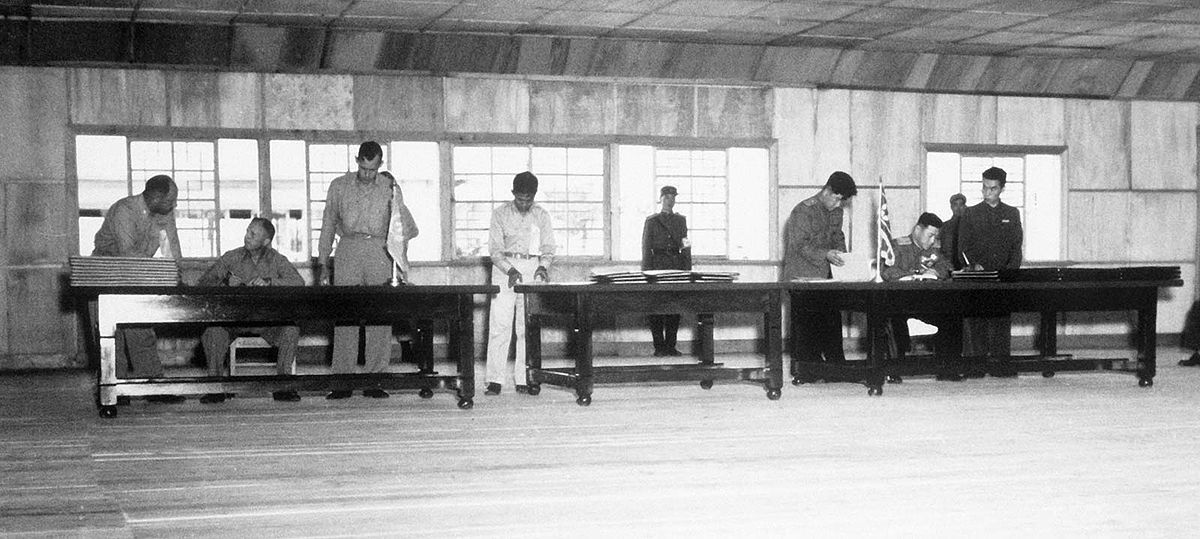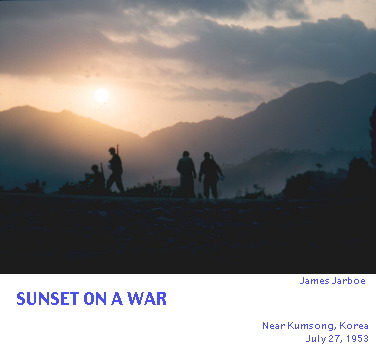
Photo Department of Defense. July 27, 1953. Panmunjom.
July 27th, 2025
Gen. William K. Harrison, Jr. (at left table) and Gen. Nam Il (at right table) sign the Korean Armistice Agreement, July 23, 1953. When the signing ceremony began, the documents were first placed on the small center table, then delivered to each side to sign. After each delegate was finished, the documents were returned to the center table.
The War Ends in a Cease Fire/Armistice.
Excerpts from David Vergun (2023) DOD News
"The Korean Armistice Agreement, signed on July 27, 1953, was the culmination of many months of bickering between officials from the United States, North Korea, South Korea, China, the former Soviet Union and United Nations forces."
"By the late spring of 1951, the battle lines had stabilized around the area of the 38th Parallel, which had previously divided the two Koreas prior to the invasion."
"On June 23, 1951, with no further progress in sight for communist forces, the Soviet Union, which backed North Korea, called for armistice talks."
"The U.S. and U.N. were amenable, and armistice talks began July 10, 1951, at Kaesong, which is in the southern part of North Korea near today’s demilitarized zone."
"However, there were some major sticking points that the two sides could not agree on."
"First and foremost was the prisoner exchange policy. U.S. diplomats, led by Secretary of State Dean Acheson, and U.N diplomats wanted a exchange that allowed the prisoners to decide if they wanted to be exchanged."
Excerpts from National Archives Prologue Magazine, Pieces of History"
"At last, at 10 a.m. on July 27, 1953, representatives of the UN forces and the North Korean army entered a specially built room in Panmunjom. Scarcely acknowledging each other, U.S. Army Lt. Gen. William K. Harrison, Jr., senior delegate for the UN Command, and Gen. Nam Il, senior delegate for the Korean People's Army and the Chinese People's Volunteers, took ten minutes to sign eighteen official copies of the tri-language Korean Armistice Agreement."
"That evening at 10 p.m. the truce went into effect. The armistice, while it stopped hostilities, was not a permanent peace treaty between nations. It is somewhat exceptional in that it is purely a military document—no nation is a signatory to the agreement."
"The Armistice Agreement suspended open hostilities and withdrew all military forces and equipment from a four-thousand-meter-wide zone, establishing the Demilitarized Zone. It further prevented both sides from entering the air, ground, or sea areas under the control of the other. Both sides agreed to release and repatriate prisoners of war and displaced persons. The agreement established the Military Armistice Commission and other agencies to discuss any violations and to ensure adherence to the truce terms."
July 27, 1953 View From OP Harry

James Jarboe was a photographer with the 3rd Signal Company. He spent time with the men of the 15th Infantry Regiment, 3rd Infantry Division on or near the outpost called "Harry".
From Jim:
Can't help but think of the young guys who never came back!
Can't forget the strange feelings I had that early evening:
Thank God it's over. Anxiety that something would happen to start it up all over again. The eerie silence at 2200 that evening. Reviewing the points to see when I might get out of that peninsula and head home.
This is a photo I took that evening.
May through July of 1953
While the truce talks sputtered along, both sides continued the fierce fighting.
From January of 1953 until 15 minutes prior to the Truce/Armistice, the fighting intensified. The North Korean and Chinese forces continued to jockey for position along the entire front in Korea. Their intent was to command all the high ridges as well as push the combined UN Forces backward well beyond the MLR - Main Line of Resistance.
The UN Forces countered these efforts with increased firepower on land, the air, and the seas surrounding North Korea. The personal narratives by our KVETS are echoed in the official histories for the Korean War.
Air operations by UN Forces which included US Air Force, Naval and Marine Aviation units, and offshore surveillance and heavy fire by Naval ships to support ground operations reached a staggering crescendo.
Our personal email and letter traffic attests to the effort and the cost. The books we have received detail the same narratives.
Visit Our Bookstore
June 13, 1953 FEAF Raid
From email sent to Ted Barker on June 13, 1999.
An example of the personal recollections of the war.
Hi Ted,
June 15 will represent the 46th anniversary of what may have been the last massed (if you can call 60 planes massed) daylight raid by prop driven bombers ever launched. The Chinese were breaking through the ROK II Corps at Kunsom, right on the front. Thirty six planes from the 3rd Bomb Wing in six, six plane elements and twenty four planes in six plane elements from the 17th provided Close Air Support raid. This raid is mentioned in "THE USAF IN KOREA", a publication of the USAF historical society. This book, however, omits any mention of the 3rd BW. I have been unable to find anyone from the 3rd that replies when I ask.
On this day FEAF flew the largest number or sorties flown ever during the Korean War ,2143. Of these the 5th AF flew 1148 of which 859 were CAS. I remember this well for I was in the #3 A/C of the lead element of the 17th. We were only supposed to be the 'strip alert' because we had just returned from a night intruder at 0400 and were called back at
0800 for an 1130 take off. When the #3 A/C aborted , the tower said "Tag you're it. and away we went. One of these days I intend to write this up - maybe for the "Sortie".
The reason that the 17th provided fewer A/C than the 3rd, was that it had fewer A/C. When the force strength was increase, the 3rd was allocated 24 A/C per squadron and the 452/17th was allotted 16 per squadron. The 17/452 had a higher in commission rate than did the 3rd because the 17th adopted the REMCO concept which the 3rd fought.
C O Smith, USAF Korea
Post Truce Korea (DMZ Era)
Immediately after the truce, both sides withdrew and began dismantling offensive and defensive positions. The Provisional DMZ Police was created and a new era on the Korean Peninsula began. The possibility of continued warfare loomed. Over the decades there have been many incidents along the Demarcation Line with lives lost.
The Korean War Project began our "DMZ Vets" section of the website within months of going live on the internet. While the bulk of our correspondence centered upon the period from June of 1950 through the end of 1953, a large volume of that correspondence was from men and women who served after the Truce.
David Benbow and Van Jenerette helped us to organize and create a focal point for all those who served in defense of the ROK - Republic of Korea.
We have mentioned in previous newsletters that a huge section of our website and social media sites are filled with interactions with men and women who served after the transition to a peace-keeping role.
Our DMZ Veterans Center was created to provide connectivity and information sharing. That area and the sister DMS BBS now contain the most visited part of the Korean War Project Website.
The History of our newsletters:
Ted Barker created our first newsletter in November of 1998. It was proving impossible to keep up with the huge volume of inbound correspondence with just the two Barker Brothers manning all the variety of correspondence.
That newsletter went out to 2000 of the people for whom we had valid email contact. The mailing list grew over the years with 65.000 contacts as the largest delivery issue.
Up through April of 2021 we have never really known how many people would be reached via Microsoft Outlook but the emailed responses indicated a decent delivery record.
Desktop email was not the most efficient outreach method as the delivery of the emails would take up to one week to exit Ted's email client.
The new delivery system shows us how many people receive our newsletters as well as how many people do not receive them.
Our audience has been shrinking dramatically over the past four years with current viewership of about 15,000 delivered per issue with an average of 7500 of them viewed.
Donor / Member Update:
The June 24th 2025 newsletter response to our fundraising request was very successful.
A huge "Thank You" to all of you who responded.
The site is free for all to use and those who participate help to ensure that we remain online whether the donation is $15.00 membership or more.
Consider supporting the mission of the Korean War Project by donations in the form of Membership/Sponsorship.
Membership - Donors
Donations/Memberships are tax deductible if you use long forms for tax deductions. IRS reports. Our EIN: 75-2695041 501(c)(3)
For those persons or groups who cannot participate, we certainly understand.
Our overall donor base has declined as former donors pass on or are no longer able to assist.
Everyone may still continue to communicate with us by direct email, phone, or letter.
The following link will allow you to see those who became the first financial contributors in 1997-98. Click through to check out the list.
Subscribe/Unsubscribe
Subscribing and Unsubscribing to our email delivered content has been hit or miss in the past. Everyone that will receive this email has consented in the past to getting copies of our email.
If we have missed any message from you to leave our list or pause delivery, this new delivery system will make sure there is no further contact for group email. Regular email, phone, or letters will always be available.
To subscribe: Subscribe to our newsletters - Here
If you have questions, let us know immediately.
27.) Contact Hal or Ted
Best regards,
Mailing address:
Korean War Project
PO Box 180190
Dallas, TX 75218
PH: 214-320-0342
Contact Hal or Ted
Best regards,
EMAIL Hal Barker, Director - hbarker@kwp.org
214-320-0342
EMAIL Ted Barker, Director - tbarker@kwp.org
214-320-0342
Korean War Project
PO Box 180190 Dallas
Texas 75218 United States

